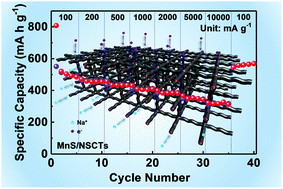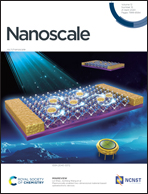Cream roll-inspired advanced MnS/C composite for sodium-ion batteries: encapsulating MnS cream into hollow N,S-co-doped carbon rolls†
Abstract
With advantages of high theoretical capacity and low cost, manganese sulfide (MnS) has become a potential electrode material for sodium-ion batteries (SIBs). However, complicated preparations and limited cycle life still hinder its application. Inspired by cream rolls in our daily life, a MnS/N,S-co-doped carbon tube (MnS/NSCT) composite with a 3D cross-linked tubular structure is prepared via an ultra-simple and low-cost method in this work. As the anode for SIBs, the cream roll-like MnS/NSCT composite has delivered the best electrochemical performance to date (the highest capacity of 550.6 mA h g−1 at 100 mA g−1, the highest capacity of 447.0 mA h g−1 after 1400 cycles at 1000 mA g−1, and the best rate performance of 319.8 mA h g−1 at 10 000 mA g−1). Besides, according to several in situ and ex situ techniques, the sodium storage mechanism of MnS/NSCTs is mainly from a conversion reaction, and the superior electrochemical performance of MnS/NSCTs is mainly attributed to the unique cream roll-like structure. More importantly, this simple method may be feasible for other anode materials, which will greatly promote the development of SIBs.



 Please wait while we load your content...
Please wait while we load your content...